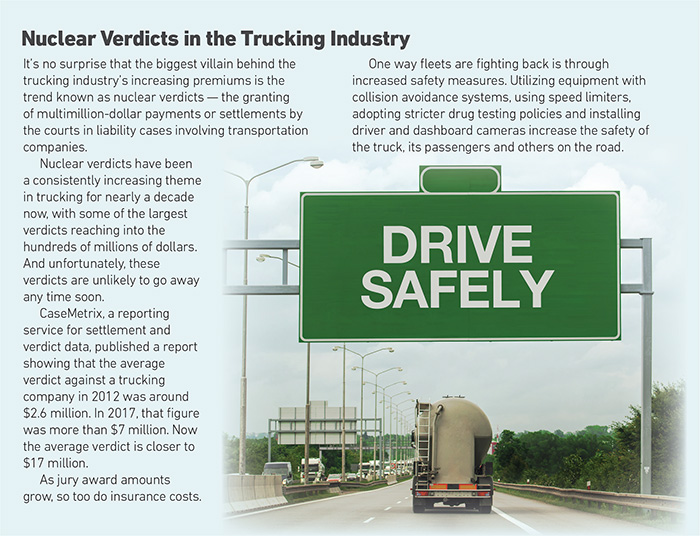There’s the Hard Market — Then There’s the Trucking Industry

There’s the hard insurance market — and then there’s whatever the trucking industry is going through.
Rates are rising, markets are shrinking fast, and insurers have become ultra-selective with buyers in the sector. Brokers say several companies have been unable to renew their programs this March, and some are even being forced to shut their doors as a result.
The insurance woes of the trucking industry are particularly painful as many companies in the sector cannot operate without thorough liability coverages.
But a number of factors have conspired to make it very hard for buyers to purchase adequate protection. Double-digit rate increases have been common in recent renewals. If not long ago, trucking firms were able to compensate the lack of domestic capacity by accessing a robust excess and surplus market, the latter of which has also dried up in recent months.
The biggest villain in this sad tale is the trend known as nuclear verdicts, the granting of multimillion-dollar payments or settlements by the courts in liability cases involving transportation companies.
In July last year, a Georgia state court awarded $280 million to the families of five victims of a road accident in Alabama involving a truck owned by a subsidiary of Schnitzer Steel, the metals recycling group. In March, RCX Solutions, an Alabama-based firm, attributed its decision to close a division to a $7.5 million verdict against the group and its inability to secure insurance at renewals.
“We read about the 200-unit trucking firms that close their doors. But we do not hear about companies that have 5, 10 or 20 units when they go out of business,” said Jimmy Proffitt, the VP of national transportation at Risk Placement Services.
“There is a lot of that going on right now.”
Liability payments worth millions of dollars have mushroomed of late, and insurers have grown ever wary of putting capacity on the line for this kind of risk. The situation is unlikely to change in the short run, however, as the industry faces significant challenges that can aggravate the risk of accidents at the same time that their financial positions turn less favorable.
Where Did the Insurers Go?
Accident rates are problematic, while the industry’s main worry — the scarcity of qualified labor — remains critical.
Trucking companies have had to rely on drivers with little experience to ride a deteriorating road infrastructure, raising the risk that their trucks will get involved in accidents. Even the emergence of social media and smartphone addiction have had an effect, as distracted driving is one of today’s main reasons behind traffic accidents.
With losses on the rise and an end of a positive economic cycle in sight, it is not surprising that insurers have soured on transportation companies.
A number of underwriters have left the segment, both in the domestic market and abroad, after several years of poor underwriting results. Wider market trends have not helped either.
Aon estimates that $250 million of capacity disappeared for umbrella and excess liability programs by mid-2019, and trucking companies have now been particularly hit by the shift in market appetite.
Brokers say prices have increased by up to 300% for higher layers of liability towers set up by trucking firms. And, even paying dearer prices, they have
had to settle for lower capacities than before.
“Insurers that were used to putting up to $25 million of capacity will now offer $5 million,” said Todd Reiser, a vice president at Lockton.
“We are seeing programs having to be built up in $5 million increments at substantially higher prices than the $25 million chunks cost of just two years ago.”
Umbrella underwriters are also demanding higher primary attachment points, reaching up to $2 million per accident in the case of clients with fleets of up to 500 vehicles, and more than that for bigger buyers, according to USI.
Finding primary capacity in the domestic market is not impossible, but it can be quite costly, especially for companies with significant loss histories.
“There are markets that will write a distressed account, at a price. There are also a number of state pools and residual markets that can operate as a last resort,” Proffitt said. “But that is a tough place for a trucking company to exist for an extended period.”
Is Self-Insurance a Viable Option?
According to the American Transportation Research Institute, insurance is climbing fast in the ranking of the most pressing worries by trucking companies, after the cost of premiums per mile increased by 17% from 2013 to 2019.
This number is set to worsen this year, and as a result, insureds are looking with ever more attention at higher deductibles and retention tools to mitigate the global cost of stitching a liability program together.
“Any large fleet, let’s say with 55 units or more, that is holding deductibles of less than $25,000 is just trading dollar for dollar in their insurance costs,” said Domenic Tesone, a managing director at NFP Canada.
“We are trying to convince some that they can buck some of the pricing trend by taking a little more retention. If they are large enough, we can look at putting them into a captive structure.”
Even then, a captive or other retention tools may not solve all problems.
It takes several months for a company to create a captive from scratch and a multiyear strategy for the vehicle to deliver on all its potential. Using a captive company to take over layers of programs that the market is not willing to accept at reasonable prices can also disrupt complex liability tower arrangements.
“Trucking companies are considering very seriously whether or not they want to self-insure certain layers in their towers,” Reiser also pointed out.
“A number of insurance companies are not willing to sit above a self-insured layer that does not have actual insurance company paper.”
Building a Risk Strategy
The general view is that the tough conditions will prevail in the market for quite a while before the situation turns more favorable to buyers.
What trucking firms can do, then, is to pump up their risk management and safety measures in order to mitigate the risk of suffering heavy liability losses. In fact, a more efficient approach to risk prevention is now a must for many insurance providers at the time of renewals.
“Some insurance companies require their clients to report every driver in real time, which is really cumbersome,” said Duke Tomei, the west regional property & casualty leader at USI.
Technologies such as collision mitigation, lane departure camera mirrors and telematics have proven effective tools to identify risks in order to implement prevention measures or to provide better training to drivers.
For companies with young fleets, extra investments can be moderate as new truck models often come with such equipment. But those that run older units may find it hard to make the investment, which does not come cheap.
Collision mitigation technology can cost thousands of dollars per truck, and in the case of cameras, not only the equipment requires investments, but also the staff necessary to analyze collected data.
But keeping a firm grip on your wallet can be even costlier: “Companies that do not invest in safety technologies will find it increasingly difficult to find insurers to partner with,” Reiser warned.
And buyers need to expedite when it comes to working on their renewals. Brokers say that, in the course of the soft market, risk managers at trucking companies have gotten used to worrying about the renewal of policies with little time to spare, as insurers would be very amenable taking their business.
That is no longer the case.
“The buying cycle needs to change. Many truckers start shopping their insurance really 50 to 90 days before expiration,” Tomei said. “They need to start working with their brokers 60 to 90 days after the renewal of the policy.” &












